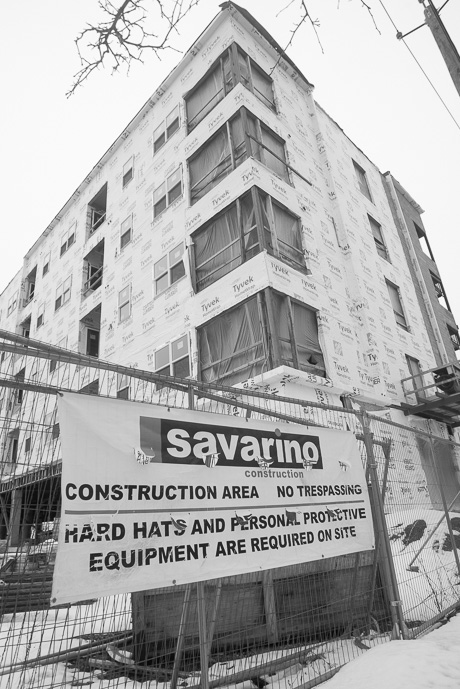
All eight City Council members signed a letter Monday night requesting that state Homes and Community Renewal officials work with the city to bump up a portion of the current Area Median Income levels at Ellicott Station.
“The city of Batavia is requesting that HCR work with us to present a better mix of incomes on the property with apartments that rent for 80 percent and 120 percent AMI,” the letter states. “We feel that this will encapsulate the workforce housing that we were promised, better align with the city’s vision of the DRI strategy, and still provide affordable housing for residents.”
Earlier Monday, during council’s business meeting, City Manager Rachael Tabelski referred to a letter that she had provided for council members to review. Apparently, they reviewed and revised the letter after the meeting. The Batavian has asked for additional details about that process and will update this article once responses are received.
Since the first application went in for Ellicott Station, local folks were excited about the prospects of longtime vacant and toxic property along the south side street getting cleaned up, renovated and repurposed. But since its inception in 2016, as City Manager Rachael Tabelski has described it, the project became fairly fluid.
“Ellicott Station has been a moving target over the last several years as the developer made various and multiple overtures to funding entities with regards to making the project financially viable. In 2019, the City supported the project’s housing component as being mixed-income that would provide housing for residents that were employed in local manufacturing in an application submitted to New York State Homes and Community Renewal from the developer,” Tabelski had said. “Furthermore, in 2020, it was confirmed that people living at Ellicott Station must be employed and not receiving government assistance."
City leaders had expressed disappointment about the apartment project’s income levels after The Batavian’s exclusive coverage published on Feb. 18. Application materials made available at Ellicott Station’s website outlined the qualifications for one- and two-bedroom units, many of which had maximum annual salaries at or below minimum wage and seemingly requiring Section 8 assistance.
One example is that two people each earning minimum wage, $14.20 an hour, are not eligible for a two-bedroom apartment at Ellicott Station because they would be earning too much (the maximum household income for two people in a two-bedroom apartment is $34,600, and two people working full-time at $14.20 would gross $59,072).
Developer Sam Savarino has said, in a follow-up interview with The Batavian, that he expects the housing complex to be filled with gainfully employed people, though he had no thorough rationale for the low maximum income levels. He said that the numbers were set a couple of years ago and can be reset once everything is up and operational at Ellicott Station if current salaries have increased.
Here in Batavia, “we would like to be known for innovative housing that has a mix of incomes to preserve our most vulnerable neighborhoods, help citizens, and provide for housing for entry-level manufacturing, service workers, and students,” the city’s letter states. “The City of Batavia, New York State, Brownfield Opportunity Area, and the Downtown Revitalization Initiative (DRI) strategy both define the need for downtown housing, including infill construction, upper floor apartments, and a demand for higher income housing, including market-rate housing.”
“When Ellicott Station Project was proposed by Savarino Companies, it was originally a market-rate housing project, however, through several financing iterations, Savarino Companies worked with HCR to finance the project. The city discovered that at the time of application, Savarino Companies applied to HCR for a mixed-income housing model but was directed by local HCR representatives to only allow residents with 50 percent to 60 percent AMI,” the letter states. “While workforce housing is the goal for the Ellicott StationSavarino Development, that is not the type of tenants that this housing will attract.”
The letter further lays out the compounding issues of the capped 50 to 60 percent Area Median Income and inflationary wage increases that will not allow working citizens to qualify to live at Ellicott Station, and “only vouchered Section 8 residents will now be able to access this property.”
“This is a fundamental change from the goals for the Ellicott Station project and does not match the BOA or DRI strategies for development of our downtown,” it states.
As a result of this fundamental change, city leaders said they are concerned that:
- Drastically increased wages for entry-level manufacturing and service jobs pay more than what would qualify for this housing complex;
- The project no longer aligns with the City’s DRI and BOA strategies, and it won’t fulfill the City’s need for market rate and workforce housing as determined from various studies;
- Low and very low-income housing — versus mixed-income housing — could set the project up for potential issues contrary to community objectives, including drug, gang, and criminal activity, per proven studies;
- Other DRI communities across the state have received HCR tax credits and rents were allowed to be 80 to 120 percent AMI in some cases — so why not here?
Photo of Ellicott Station in progress at 50 Ellicott St., Batavia, by Howard Owens.
